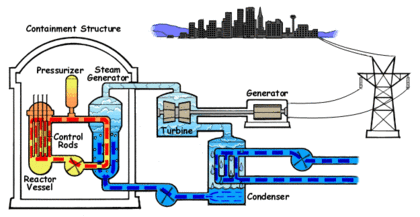
Back Kernaandrywing Afrikaans دفع نووي Arabic Ядрена силова установка Bulgarian Jaderný pohon Czech Kernenergieantrieb German Propulsión nuclear Spanish Propultsio nuklear Basque پیشرانه هستهای Persian Propulsion nucléaire French नाभिक नोदन Hindi
Nuclear propulsion includes a wide variety of propulsion methods that use some form of nuclear reaction as their primary power source.[1] The idea of using nuclear material for propulsion dates back to the beginning of the 20th century. In 1903 it was hypothesized that radioactive material, radium, might be a suitable fuel for engines to propel cars, planes, and boats.[2] H. G. Wells picked up this idea in his 1914 fiction work The World Set Free.[3] Many aircraft carriers and submarines currently use uranium fueled nuclear reactors that can provide propulsion for long periods without refueling. There are also applications in the space sector with nuclear thermal and nuclear electric engines which could be more efficient than conventional rocket engines.

- ^ Trakimavičius, Lukas. "The Future Role of Nuclear Propulsion in the Military" (PDF). NATO Energy Security Centre of Excellence. Archived from the original (PDF) on 2021-10-18. Retrieved 2021-10-15.
- ^ Some practical uses of radium rays, The Republic, Sunday, September 13, 1903
- ^ The new source of energy, The World Set Free, H G Wells, Collins, London and Glasgow, 1956 edition, page 55